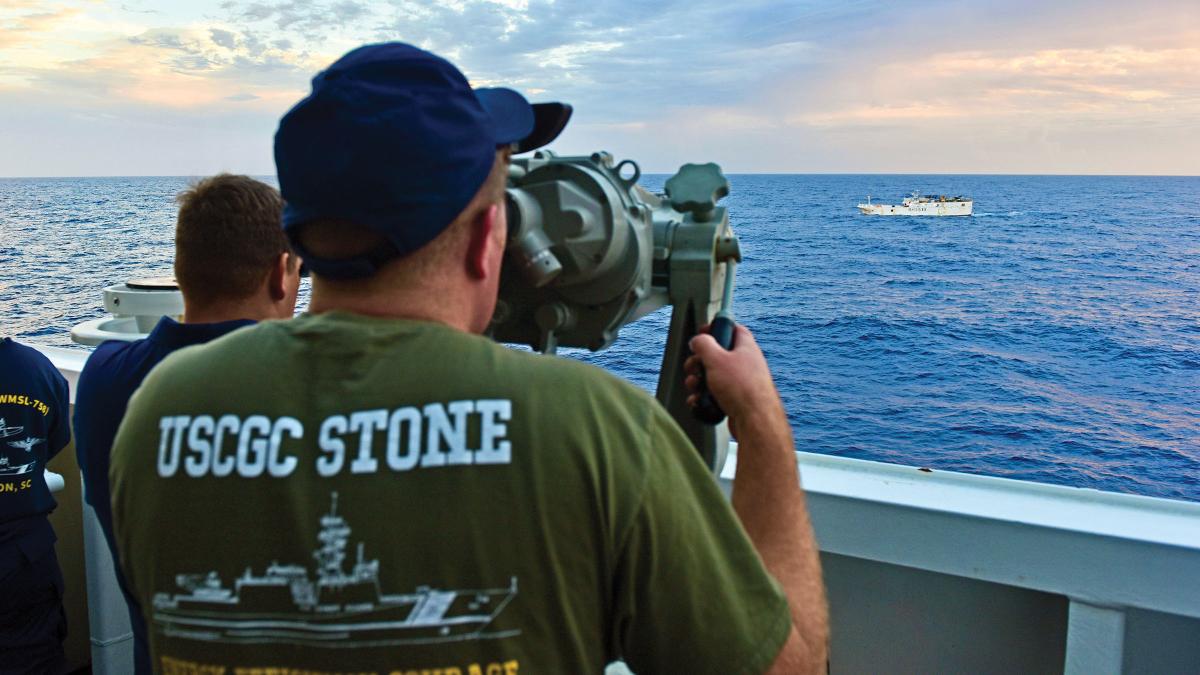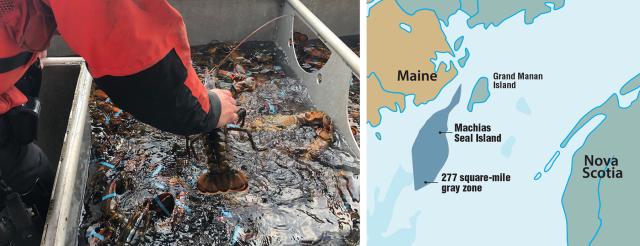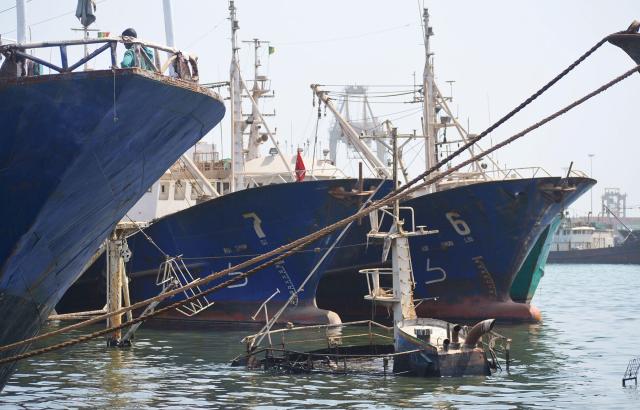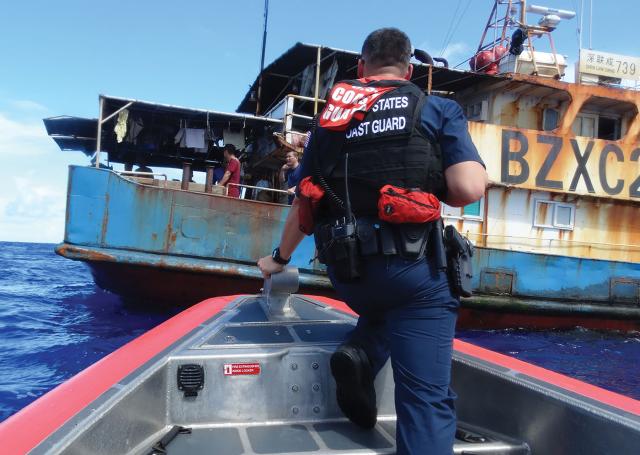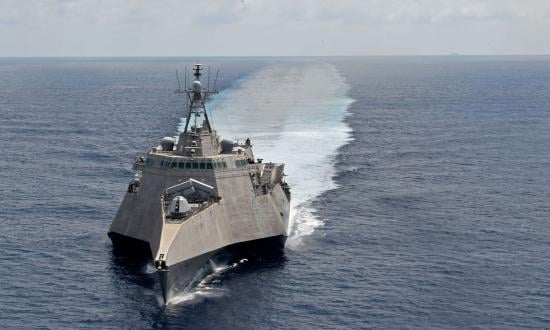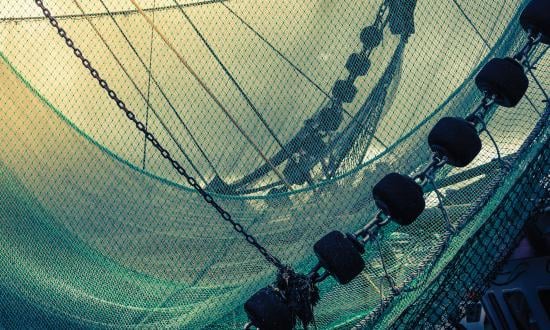A few miles off the coast of the far northeast corner of the continental United States is a disputed international boundary and a “gray zone” of water over which the United States and a peer nation have competing claims of sovereignty. These waters offer a warning regarding the effectiveness of the military’s current “culture of presence.”
Often viewed as areas of competition short of conflict, such gray zones actually are likely flashpoints, and restricting U.S. operations in these disputed areas to showing presence is an untenable practice. It has fostered a dangerous culture within U.S. naval forces, who increasingly confuse presence with action. Such a culture gives the advantage to belligerent nations and nonstate actors and must be rooted out of strategic visions and policies in favor of a “culture of aggressive nonviolence,” meaning one enabled to seize, burn, and sink with due care for the preservation of life.
Gray in the Gulf of Maine
Widely known as the Gulf of Maine (GOM) Gray Zone, the 277 square miles of disputed water off the U.S. Eastern Seaboard encircle the 20-acre Machias Seal Island and a literal rock named North Rock. Since its earliest days of independence, the United States has maintained its claim of sovereignty over these tiny outcrops, despite the presence on the island since 1832 of a Canadian-built lighthouse—one Canada has made a conscious effort to man, even after the lighthouse was automated.1 Though the land itself is of little economic value, the surrounding waters are home to the American lobster and are some of the richest fishing grounds in the world.
The conditions in the Gulf of Maine should sound familiar to those with knowledge of the highly contested South China Sea, where man-made landmasses are serving as justification for new claims of sovereignty and associated fishing rights. What are less likely to be familiar are the realities of operations in these disputed waters and the ineffectiveness of federal living marine resource, or fisheries, law enforcement.
With no clear jurisdictional boundaries, no laws that extend to foreign vessels fishing extraterritorially, and a desire to avoid international conflict, the only vessels clearly subject to U.S. law in the GOM Gray Zone are those flying the Stars and Stripes. All others are expected to be deterred from committing crimes and aggressive actions by the presence of U.S. patrols or, more accurately, the possibility one will be assigned within even radar range. This translates into U.S. citizens being held accountable for fishery violations and other crimes by patrolling U.S. Coast Guard cutters, while foreign-flagged vessels are left to fish and transit with impunity absent the action of their own nations’ forces.2
This reality of gray zones seems unrecognized by strategists, who tout the practice of presence in disputed waters because of its expected deterrent effect. Presence without authorization for substantive action, however, can erode trust in military and policing forces by those who rely on their protection and embolden foreign nations and nonstate actors by showing a lack of resolve to decisively address their conduct.
The Limits of Presence
Advantage at Sea, a joint U.S. Navy, Marine Corps, and Coast Guard strategy released in December 2020, describes gray zone operations as day-to-day competition and tasks the Coast Guard’s modernized fleet of cutters with providing intermediate force capabilities short of lethal force to contest coercive actions and counter malign activities. But when under orders to simply provide presence or show the flag, capability accomplishes nothing when a foreign vessel’s crew decides to engage in “malign” behavior.
Though below the threshold of war, malign behavior can yield incremental gains and accumulate into long-term advantages.3 Malign behavior does not have to be aggressive to achieve such an outcome; simply pulling lobster uncontested from waters claimed by the United States in the presence of patrolling cutters threatens the credibility of maritime forces and degrades national sovereignty. Advantage at Sea’s counter to such behavior is persistent forward presence and the deployment of targeted capabilities, assuming that simply exposing malign behaviors will solve problems. The reality is these behaviors are well documented and reported—and yet they persist.
Conflicts between U.S. and Canadian fishermen in the GOM Gray Zone have been widely reported for decades, with gear sabotage, vessel collisions, and the exchange of gunfire, all answered by the assignment of a U.S. Coast Guard cutter to patrol the area to provide presence and enforce laws on its own citizens. Absent a similar response by Canada, however, the foreign fishermen face no threat of enforcement beyond U.S. documentation and reporting of their conduct to Canadian authorities, a practice that cedes the advantage to the Canadians.4
Because of disparities in fishery management practices between the two nations, failure to achieve consistent enforcement threatens the region’s fish stock and related conservation efforts. In the case of American lobsters, U.S. conservation efforts include codified measures to protect endangered right whales—which number fewer than 400 globally—from entanglements in lobster trap gear. While the United States has enacted a series of regulations, including weak links on buoy lines, minimum trap numbers, and stringers to identify where gear is set, the Canadians lack any such regulations for passive prevention of entanglements. They rely instead on orders to secure from fishing upon whale sightings, a strategy that does not remove already deployed gear from the water or its danger to the whales.5
In the GOM Gray Zone, such differences risk whale entanglements by Canadian gear being attributed to Maine lobstermen, an outcome that jeopardizes continued public support for the fishery. Legal action already is pending in federal courts to establish a moratorium on commercial lobster fishing to protect the whales.6 If the United States has a legitimate claim to the waters, it must do more than maintain presence. It must actively enforce its laws and maintain its sovereignty.
IUU (Non)Enforcement
Illegal, unreported, and unregulated (IUU) fishing enforcement is not a new mission for the Coast Guard, though its scope and range are likely to expand under the latest strategies. Ocean Guardian, the service’s fisheries enforcement strategic plan, has guided at-sea enforcement for decades and focuses on three strategic priorities: protecting the U.S. exclusive economic zone (EEZ) from foreign encroachment, enforcing domestic living marine resource laws, and ensuring compliance with international agreements.7
An IUU strategic outlook released in 2020 complements Ocean Guardian with a focus on IUU fishing. Notably, its first line of effort, “Promote Targeted, Effective, Intelligence-Driven Enforcement Operations,” defines enforcement as “detecting and deterring,” adding that “documenting and reporting” illegal activity supports the process for regional fishery management organizations and the international community to hold the flag states of offending vessels accountable. To that end, the service intends to “increase its law enforcement presence on the high seas and in the EEZs of partner nations.”8
It is a strategy founded on a culture of mere presence, with the lackluster goal of documenting conduct so other nations might act on it. This culture is fostered even domestically, where despite being the primary maritime law enforcement agency for U.S. living marine resources, the Coast Guard simply documents fishery violations and refers the evidence for enforcement action by the National Oceanic and Atmospheric Administration (NOAA). When a Coast Guard boarding team detects a violation of domestic fisheries law, it must seek a statement of no objection from a flag officer for any proposed enforcement action, even for the referral of a case for civil penalty under NOAA’s internal process. Such flag-level authorization is required even though the service is merely documenting and referring violations. Administrative civil penalties for fisheries violations must be initiated by NOAA, but cases ultimately are decided by Coast Guard administrative law judges, making NOAA an unnecessary addition to the framework.9
This administrative civil penalty process has become the preferred route to address violations, as it eliminates the need to involve the federal courts. However, it typically yields no action to seize the involved vessel, its fishing gear, or its catch, as allowed by the overarching law. In addition, the Coast Guard and NOAA rarely approach the U.S. Attorney’s Office to bring criminal charges against suspects, despite evidence of sustained overfishing for nearly a third of commercially caught species, resulting in repeated instances of criminal conduct and a documented compliance rate of fishermen with federal laws that has remained below 30 percent for years.10
Termed “unity of effort” by the latest strategies, this relationship is more fittingly described as “document and refer,” a practice that vests endgame authority with an agency with no investment in the dangerous on-scene work required to make the interdiction—and therefore little real incentive to make that work meaningful. This problem extends to international enforcement efforts, where NOAA’s role is filled by the foreign government having jurisdiction, often one without any legal framework to support convictions and other penalties for fishery crimes.
Substantive Action Needed
A real deterrent to IUU fishing is substantive action, such as seizing, burning, and sinking the conveyances used to facilitate the behavior. This is critical when the malign conduct involves the taking of natural resources, as with the IUU fishing by Chinese fleets. China has the world’s largest distant-water fishing fleet, with more than 2,000 vessels, and is identified by Coast Guard leaders as the “most pressing, long-term strategic threat” to U.S. maritime interests.11 Documenting the conduct of these vessels but failing to act decisively to end it only allows continued exploitation of natural resources and erosion of confidence in U.S. capabilities and resolve; exposure is unlikely to generate any significant international coalition against the vessels’ parent nation.
The Coast Guard’s newest national security cutter, USCGC Stone (WMSL-758), recently completed a mission to the South Atlantic to provide further documentation of IUU by hundreds of Chinese industrial squid fishing vessels.12 Last September, the USCGC Bertholf (WMSL-750) “provided persistent presence and surveillance” to the Ecuadorian government as it monitored many vessels from the same fleet off the Galapagos.13 Despite these U.S.-led patrols, the Chinese continue to fish with impunity—and on a scale that amounts to wholesale slaughter of fish stocks.
By contrast, when the Argentine Coast Guard detected a Chinese trawler illegally fishing within its territorial waters in 2016, its patrol boat pursued the trawler with the intent of seizing it. When “the offending trawler performed maneuvers designed to force a collision with the coast guard, putting at risk not only its own crew but coast guard personnel,” the Chinese crew were ordered to abandon ship for their own safety before shots were fired into the vessel until she sank. China’s foreign ministry lodged a protest and demanded an explanation, but despite the diplomatic grandstanding, the trawler responsible for the malign conduct will no longer ply the world’s oceans or threaten the sovereignty of Argentinian waters.14
The Sea Shepherd movement, a collection of affiliated nonprofit conservation organizations that have been branded pirates by a U.S. district court, terms such decisive actions “aggressive nonviolence” and frequently engages in them. It broadcasts video evidence of IUU fishing through multiple popular television series and movies, employing exposure to great effect in meeting its fundraising goals. But Sea Shepherd also takes action against the malign behavior, seizing and destroying fishing equipment and scuttling vessels with a history of violations of international prohibitions against whaling, all without physical injury to those responsible.
The Indonesian government has adopted a similar strategy, and in April 2017, it lined up and sank 81 confiscated fishing boats with explosives as part of its ongoing effort to combat illegal poaching by foreign fishermen in the Indonesian EEZ.15 Though aggressive nonviolence can be dramatic, it also can be tempered. The Indonesians, for example, abandoned explosions in favor of using pumps and hoses to flood and send another fleet of 51 seized vessels to the bottom in 2019.16
For those who say the United States is above such actions, recognize that current federal living marine resource laws—including the Magnuson-Stevens Fisheries Conservation Management Act, the Endangered Species Act, the Lacey Act, and the Marine Mammal Protection Act—authorize enforcement officers to seize vessels, catch, gear, and other evidence whenever a prohibited act is detected. Unfortunately, domestic enforcement of these federal laws is almost exclusively deferred to NOAA, which almost certainly would decline authorization for such measures and instead opt for its ineffective administrative civil penalty process. Because these laws lack the verbiage needed for extraterritorial application, they are not applied beyond the U.S. EEZ, a condition that could be remedied through legislation.
The Coast Guard succeeds in its high-seas drug interdiction missions because it is enabled to act by legal frameworks such as the Maritime Drug Law Enforcement Act, which makes trafficking narcotics a federal crime on board any vessel whose “flag nation has consented or waived objection to the enforcement of the United States law by the United States.” Penalties authorized by the act also allow for the detention and arrest of suspects and the seizure of contraband and other evidence. Other legislation is applied to accomplish the at-sea destruction of seized vessels as hazards to navigation.
Unfortunately, for IUU fishing, the current legal framework is unsupportive of substantive enforcement action. In Advantage at Sea, the leaders of the Sea Services state, “the boldness of our actions must match the magnitude of our moment. The security of our nation depends on our ability to maintain advantage at sea.”17 Such an advantage will not be achieved or maintained by presence alone. Without substantive action, Canadians will continue to fish the GOM Gray Zone. China will continue to use its fishing fleets to gradually assert control over contested areas, all the while threatening the sustainability of fish stocks in the EEZs of developing nations throughout the world. Global competition for fish will increase and devolve into violence as fisheries collapse and the protein they provide becomes increasingly scare. The “firm and persuasive operations to confront malign behavior” cannot be mere presence and must instead translate into legislation that enacts criminal laws with extraterritorial applications and strategies and policies that enable and even encourage U.S. forces to seize, burn, and sink wherever warranted.
1. Heather Brady, “The ‘Gray Zone’ between the U.S. and Canada: Why This Murky Border Matters,” National Geographic, 23 July 2018.
2. “Lobster War: About the Film,” 2018, https://lobsterwar.com/aboutthefilm.
3. U.S. Coast Guard, Advantage at Sea: Prevailing with Integrated All-Domain Naval Power, December 2020, www.uscg.mil/tsms.
4. “Lobster War: About the Film.”
5. NOAA Fisheries, “United States and Canada Must Sustain Additional Efforts to Reduce North Atlantic Right Whale Mortalities, Serious Injuries,” 27 January 2020.
6. Chris Chase, “Massachusetts Officials Plan Lobster-fishing Bans to Protect Right Whales,” Seafood Source, 22 December 2020.
7. U.S. Coast Guard, Ocean Guardian (Washington, DC: 2014), www.uscg.mil/Portals/0/Strategy/USCG_OceanGuardian_Final.pdf.
8. U.S. Coast Guard, Illegal, Unreported, and Unregulated Fishing Strategic Outlook (Washington, DC: September 2020), www.uscg.mil/Portals/0/Images/iuu/IUU_Strategic_Outlook_2020_FINAL.pdf.
9. NOAA, National Marine Protected Areas Center, Enforcing U.S. Marine Protected Areas: Synthesis Report (Silver Spring, MD: 2005), https://nmsmarineprotectedareas.blob.core.windows.net/marineprotectedareas-prod/media/archive/pdf/publications/enforcement.pdf.
10. U.S. Coast Guard, Annual Performance Report Fiscal Year 2017 (Washington, DC: 2017), www.uscg.mil/Portals/0/documents/budget/FY17%20APR%2015%20May%2018%20-%20Final%20-%20POSTED.pdf.
11. U.S. Coast Guard, Advantage at Sea.
12. Coast Guard Atlantic Area Public Affairs, “U.S. Coast Guard Cutter Stone (WMSL-758) Completes Operation Southern Cross,” SouthCom.mil, 5 March 2021.
13. U.S. Coast Guard, “Coast Guard, Ecuadorian Navy Conduct Joint Patrol Off Galapagos Islands,” news release, 3 September 2020.
14. Mark Godfrey, “Argentine Coast Guard Opens Fire on Chinese Fishing Vessel,” SeafoodSource, 4 March 2018.
15. Francis Chan, “Indonesia Blows Up and Sinks Another 81 Fishing Boats for Poaching, The Straits Times, 2 April 2017.
16. Associated Press, “Indonesia Sinks 51 Foreign Boats to Fight against Poaching,” Navy Times, 5 May 2019.
17. U.S. Coast Guard, Advantage at Sea:.



